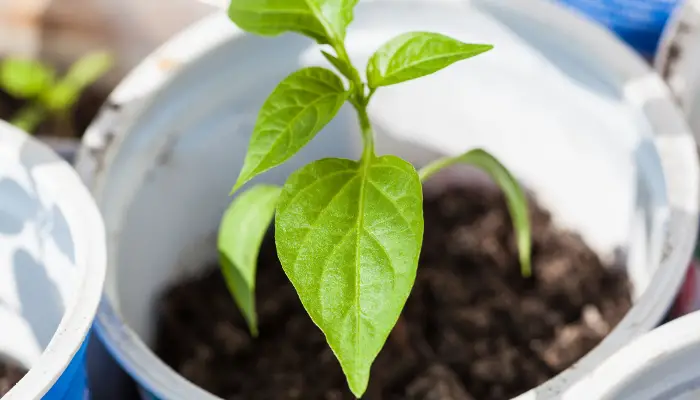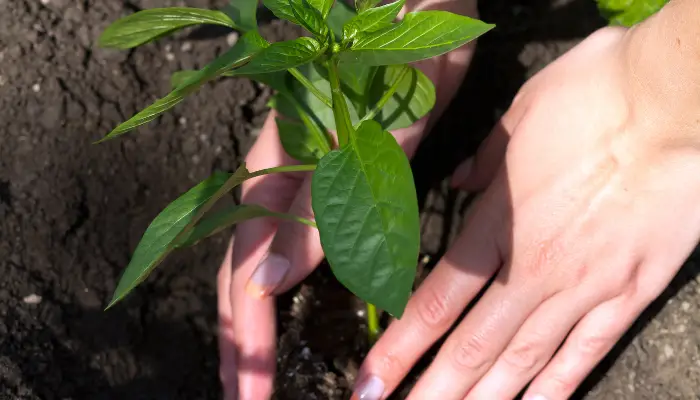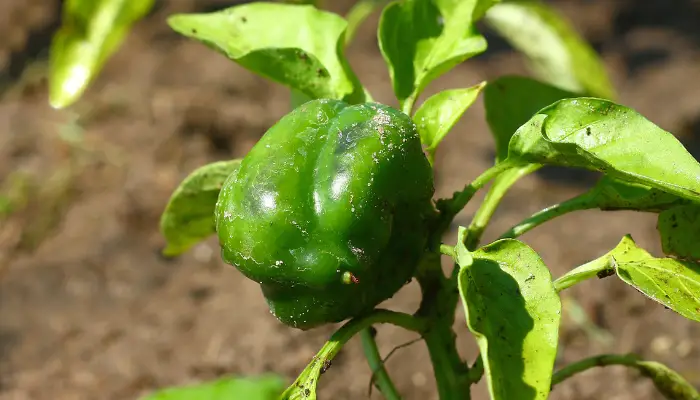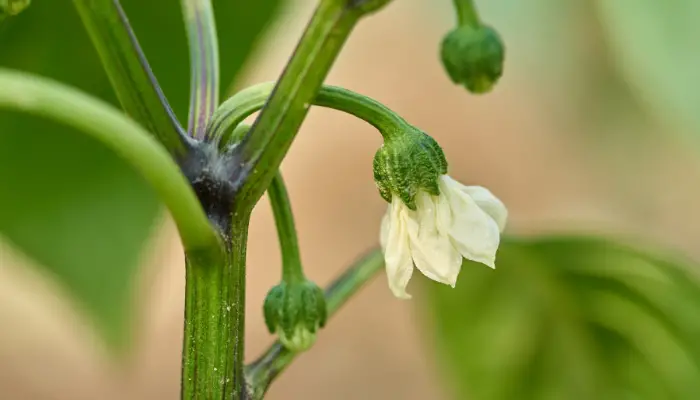Bell peppers are colorful and crunchy fruits that belong to the nightshade family, along with tomatoes, potatoes and eggplants.
They are native to Mexico, Central and South America, but can be grown in many climates as long as they have enough warmth and sunlight. Bell peppers come in different sizes, shapes and colors, from green to red, yellow, orange, purple and even white.
They have a mild and sweet flavor and can be eaten raw or cooked in various dishes.
In this post, we will give informative details on Bell Pepper Plant Care, including best practices for growing conditions and growth.

To Grow Bell Peppers Successfully, You Need to Follow These Steps:
Step 1.
Start your seeds indoors about 10 to 12 weeks before the last frost date in your area. Bell peppers need a warm and moist environment to germinate, so you can use a heating pad or a sunny window to provide them with the optimal temperature of 75 degrees Fahrenheit. Plant the seeds about a quarter of an inch deep in a planting tray filled with soil, and water them regularly.
Step 2.
Harden off your seedlings before transplanting them outdoors. Bell peppers are sensitive to transplant shock, so you need to acclimate them to the outside conditions gradually. About 10 days before planting, expose your seedlings to the outdoor environment for a few hours per day, increasing the time and intensity each day. This will help them adjust to the temperature, wind and sun, and prevent wilting or stunted growth.
Step 3.
Transplant your seedlings outdoors when the soil temperature reaches at least 65 degrees Fahrenheit, and the nighttime temperature is above 60 degrees Fahrenheit. Choose a sunny and well-drained spot for your bell pepper plants, and space them 18 to 24 inches apart in rows 2 1/2 to 3 feet apart. Dig a hole deep enough to cover the root ball, but leave the seedling leaves on the surface. You can also use black plastic mulch to keep the soil warm and moist, and prevent weeds from growing.
Step 4.
Water your bell pepper plants regularly, providing 1 to 2 inches of water per week. Water around the base of the plant, rather than overhead, to avoid spreading diseases. You can also fertilize your plants with compost or a balanced 10-10-10 fertilizer when you see the first peppers forming, and repeat every two to three weeks until harvest.
Step 5.
Harvest your bell peppers when they reach the desired size and color. You can pick them when they are green, or wait until they turn red, yellow, orange or other colors, depending on the variety. To harvest, cut the stem with a sharp knife or scissors, leaving a small portion attached to the fruit. Handle the peppers gently, as they can bruise easily.
Some Tips to Keep in Mind When Growing Bell Peppers Are:

1). Choose a variety that suits your climate and taste. There are many types of bell peppers, from miniature to giant, from blocky to tapered, from sweet to bitter. Some popular varieties are California Wonder, Big Bertha, Purple Beauty, Chocolate Bell and Golden Bell.
2). Protect your plants from pests and diseases. Bell peppers can be affected by aphids, flea beetles, cutworms, hornworms, blossom end rot, bacterial spot, anthracnose and mosaic virus. To prevent or control these problems, you can use organic methods such as crop rotation, companion planting, row covers, traps, neem oil, baking soda, milk spray and beneficial insects.
3). Prune your plants to increase yield and quality. Pruning can help your plants focus their energy on producing bigger and better fruits, rather than growing more leaves and branches. To prune, remove the lower leaves and branches, as well as any damaged or diseased ones. You can also pinch off the first few flowers to encourage more branching and fruiting later on.
4). Support your plants with stakes or cages. Bell peppers can grow tall and heavy, and may need some support to prevent them from falling over or breaking. You can use wooden stakes, metal cages, trellises or bamboo poles to provide stability and structure for your plants. Tie the stems loosely to the supports with twine or cloth strips, and adjust as needed.
How Long Does it Take For a Bell Pepper Plant to Produce Fruit?

Bell Pepper Plant Care
A bell pepper plant takes 90 to 120 days to produce fruit from seed that can be harvested. However, this may vary depending on the variety, climate, and growing conditions. Some types of bell peppers can be picked when they are green, which saves some time, while others need to ripen to different colors. You can learn more about the growth stages of a bell pepper plant from this source.
What is The Best Time to Plant Bell Peppers?
The best time to plant bell peppers is when the soil and air temperatures are warm enough for them to thrive. Bell peppers are heat-loving plants that need at least 6 to 8 hours of sunlight per day and a soil temperature of 65°F (18°C) or higher. Depending on your climate, this may be in late spring or early summer, after the last frost date. You can start bell pepper seeds indoors 10 to 12 weeks before planting them outside, or buy transplants from a nursery.
What is The Ideal Soil pH For Bell Peppers?
The ideal soil pH for bell peppers is between 6.0 and 6.8, which is slightly acidic. This range allows the bell pepper plant to absorb nutrients like calcium and phosphorus, which are essential for its growth and development. If the soil pH is too high or too low, it can affect the plant’s ability to take up nutrients and water, and may cause symptoms such as yellowing leaves, stunted growth, or poor fruit quality.
How Do I Adjust the Soil pH For Bell Peppers?
To adjust the soil pH for bell peppers, you need to first test your soil using a pH meter, a pH strip, or a chemical kit. You can also send a soil sample to a lab for a more accurate analysis. The ideal soil pH for bell peppers is between 6.0 and 6.5, which is slightly acidic.
If your soil is too alkaline (above 7.0), you can lower the pH by adding organic matter such as compost, manure, peat moss, or pine needles. You can also use a soil acidifier, such as sulfur, aluminum sulfate, or iron sulfate, following the manufacturer’s instructions.
If your soil is too acidic (below 6.0), you can raise the pH by adding lime, such as dolomite or calcitic lime. Lime also provides calcium and magnesium, which are essential for pepper growth. You can also use wood ash, oyster shells, or crushed eggshells as natural sources of lime.
It is important to apply the amendments gradually and in small amounts, and to test the soil pH again after a few weeks. Adding too much or too little can cause more harm than good to your plants.
How do I Prevent Blossom End Rot in Bell Peppers?

Bell Pepper Plant Care
Blossom end rot is a condition that affects peppers and tomatoes due to a calcium deficiency in the plant. It causes dark and mushy spots on the bottom or sides of the fruits, and can be prevented by following some simple steps. Here are some tips to avoid blossom end rot in your pepper plants:
- Water your plants regularly and evenly, providing 2-3 inches of water per week. Avoid over-watering or under-watering, as this can stress the plant and affect its calcium uptake. You can use mulch to help retain soil moisture and prevent evaporation.
- Fertilize your plants with a balanced and organic fertilizer that is low in nitrogen and potassium, and not ammonia-based. Excess nitrogen and potassium can interfere with calcium absorption, and ammonia can lower the soil pH and make calcium less available.
- Add calcium to your soil if it is deficient or acidic. You can test your soil pH and calcium levels with a kit or a meter, or send a sample to a lab for analysis. The ideal soil pH for peppers is between 6.0 and 6.8, which is slightly acidic. You can add lime, gypsum, bone meal, eggshells, or oyster shells to increase the calcium and pH of your soil. Apply the amendments gradually and in small amounts, and test the soil again after a few weeks.
- Spray your plants with a calcium solution or a seaweed extract as a foliar feed. This can provide a quick boost of calcium to the developing fruits and help prevent blossom end rot. You can buy a ready-made product or make your own by dissolving 1 tablespoon of Epsom salt in a gallon of water. Spray the plants once a week until the fruits are mature.
What Are Some Common Diseases That Affect Bell Pepper Plants?
Some common diseases that affect bell pepper plants are:
Bacterial leaf spot
This is a bacterial infection that causes yellow, brown, or black spots on the leaves, which may fall off or form lesions. It can also affect the fruits, causing raised, corky spots. It can be prevented by using clean seeds, soil, and water, and by spraying with a copper-based fungicide
Mosaic virus
This is a viral infection that causes mottled, distorted, or stunted leaves and fruits. It can be transmitted by insects, seeds, or tools. It cannot be cured, but it can be avoided by using resistant varieties, removing infected plants, and controlling pests
Blight
This is a fungal infection that causes dark spots on the leaves and stems, which may wilt and die. It can be spread by water, wind, or soil. It can be controlled by using fungicides, crop rotation, and removing infected plants and debris
Damping off
This is a fungal infection that affects seedlings, causing them to rot and collapse. It can be caused by poor drainage, overwatering, or contaminated soil. It can be prevented by using sterile soil, pots, and tools, and by watering carefully
How to Control Pests on Bell Pepper Plants?
There are many types of pests that can attack your bell pepper plants, such as aphids, flea beetles, armyworms, corn borers, leafrollers, weevils, and spider mites. To control these pests, you can use a combination of natural and organic methods, such as:
- Spraying your plants with water, soap, or neem oil to dislodge or kill the pests.
- Introducing or encouraging beneficial insects, such as ladybugs, lacewings, or parasitic wasps, that prey on the pests.
- Planting companion plants, such as marigolds, basil, or garlic, that repel or distract the pests.
- Removing the pests by hand or with a vacuum, and disposing of them properly.
- Using row covers, nets, or collars to protect your plants from pests.
- Rotating your crops, cleaning your garden, and removing infected plants to prevent the pests from spreading.
How to Make Bell Pepper Plants Bushier?
One way to make your bell pepper plants bushier is to prune them. Pruning can help your plants grow more branches and leaves, which can increase the number of flowers and fruits. To prune your bell pepper plants, you can follow these steps:
- Wait until your plants are at least 12 inches tall and have several sets of true leaves.
- Cut off the top of the main stem, just above a node where a leaf or branch emerges. This will encourage the plant to produce more side shoots.
- Remove any weak, damaged, or diseased branches, as well as any suckers that grow between the main stem and the branches. This will help the plant focus its energy on the healthy and productive parts.
- Repeat the process as needed throughout the growing season, but avoid pruning too much or too late, as this can reduce the yield and quality of the peppers.
Pruning is not the only way to make your bell pepper plants bushier. You can also try these tips:
- Choose a variety that is naturally bushy and compact, such as Mini Bell, Sweet Banana, or Gypsy.
- Start your seeds indoors early and transplant them outdoors when the weather is warm and stable. This will give your plants more time to grow and branch out.
- Pinch off the first few flowers that appear on your plants. This will delay the fruiting, but it will also stimulate more branching and flowering later on.
- Fertilize your plants with a balanced and organic fertilizer that is low in nitrogen and high in phosphorus and potassium. Nitrogen promotes leaf growth, while phosphorus and potassium promote flower and fruit development.
- Provide your plants with plenty of sunlight, heat, and water. Bell peppers are tropical plants that need at least 6 to 8 hours of full sun per day, a soil temperature of 65°F (18°C) or higher, and 1 to 2 inches of water per week.
What is The Best Way to Store Harvested Bell Peppers?
There are different ways to store harvested bell peppers, depending on how long you want to keep them and how you plan to use them. Here are some of the common methods:
Refrigerator
This is the best option if you plan to use your bell peppers within a week or two. Make sure your peppers are dry and place them in a plastic bag with holes for air circulation. Store them in the crisper drawer of your fridge. Cut bell peppers should be stored in an airtight container with a paper towel to absorb moisture
Freezer
This is a good option if you want to preserve your bell peppers for several months. You can freeze them whole or sliced, but it is better to slice them first for easier use. Arrange the peppers on a baking sheet in a single layer and freeze them for an hour. Then, transfer them to a freezer bag and squeeze out as much air as possible. Frozen peppers can be used in soups, stews, stir-fries, and other dishes
Pickled
This is a tasty option if you like the tangy flavor of pickled peppers. You can pickle your bell peppers using vinegar, salt, sugar, spices, and herbs. You can use a water bath canner to seal the jars and store them in a cool, dark place for up to a year. Or, you can use a refrigerator method and store them in the fridge for a few weeks. Pickled peppers can be used in salads, sandwiches, pizzas, and more
Dried
This is a simple option if you have a dehydrator or an oven. You can dry your bell peppers by slicing them and placing them on the dehydrator trays or the oven racks. Dry them at a low temperature (130-140°F or 52-60°C) for 4-12 hours, until they are brittle. Dried peppers can be stored in an airtight container in a cool, dry place for up to a year. You can also grind them into powder or flakes, or rehydrate them in water or broth for cooking




